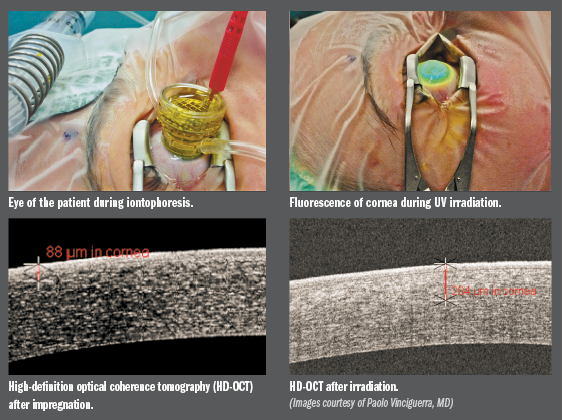Article
Study: Ionotophoresis efficient, effective for riboflavin delivery
Results from preclinical studies and early clinical experience show that iontophoresis is an efficient and effective method for delivering riboflavin into the cornea, while CXL performed after the procedure is associated with good results in early follow-up.
Take-Home
Results from preclinical studies and early clinical experience show that iontophoresis is an efficient and effective method for delivering riboflavin into the cornea, while CXL performed after the procedure is associated with good results in early follow-up.
By Cheryl Guttman Krader; Reviewed by Paolo Vinciguerra, MD
Milan, Italy-Early experience with corneal crosslinking (CXL) using iontophoresis-assisted riboflavin imbibition shows it is a promising technique for treating eyes with progressive keratoconus, said Paolo Vinciguerra, MD.
“Reliable delivery of riboflavin into the cornea is critical to the safety and success of CXL,” said Dr. Vinciguerra, professor of ophthalmology, Humanitas University of Milan, Italy. “We have found that the iontophoresis-assisted method results in immediate strong corneal fluorescence after UVA irradiation comparable to that achieved with the standard epi-off technique, and in vivo OCT imaging shows a visible demarcation line representing riboflavin penetration depth at 200 to 250 mµ.
“Patient follow-up demonstrates the technique results in keratometric flattening by 3 months post-CXL, which is sooner than what is seen using other CXL techniques,” he continued. “In addition, we have documented improvements in corneal biomechanical properties . . . these are only preliminary results from a limited number of eyes with short follow-up, however, they are very promising.”

About the procedure
Iontophoresis is a non-invasive approach that uses electrical current to enhance tissue penetration by an ionized compound. Riboflavin is well suited for use in iontophoresis, Dr. Vinciguerra explained, because it is negatively charged at physiological pH, has high aqueous solubility, and has a relatively low molecular weight that enables its transport into the cornea.
The procedure involves placement of the 8-mm ionotophoresis device onto the cornea using a 9-mm annular suction ring. The suction ring is fixed onto the cornea with low suction and is connected to a battery-powered DC generator emitting a current of 1 mA (I-ON XL, Sooft Italia). A second grounding electrode is placed on the patient’s forehead, and the suction ring is filled with 0.5 mL of a hypotonic 0.1% riboflavin solution (Ricrolin +, Sooft Italia).
After just 5 minutes of iontophoresis, the concentration of riboflavin in the cornea is close to 2/3 that achieved following the standard 30-minute protocol of topical administration to a debrided cornea. Ultraviolet A (UVA) irradiation is then performed using 10 mW/cm2 for 9 minutes.
Dr. Vinciguerra-along with colleagues in collaboration with Eberhard Spoerl, PhD, University of Dresden, Germany-obtained proof of principle for iontophoresis-assisted riboflavin delivery in preclinical studies using human cadaver eyes.
An initial investigation compared biomechanical changes (increase in Young’s modulus) occurring with different methods of riboflavin impregnation and UVA irradiation protocols.
The results showed the best outcome was achieved in the iontophoresis group, which was only 1 of 5 experimental groups, and they were confirmed in a second experiment.
Based on this experience, a clinical trial was initiated enrolling patients aged 18 to 45 years with progressive keratoconus and no previous ocular surgery. In addition to showing keratometric flattening, data collected in the study indicated that patients experience less pain with the ionotophoresis riboflavin delivery versus with the standard technique, although some patients did develop an epithelial defect.
Follow-up showed good recovery of BCVA with improvements in higher order aberrations. There is no evidence of endothelial toxicity.
Paolo Vinciguerra, MD
E: paolo.vinciguerra@humanitas.it
Dr. Vinciguerra has no relevant financial interests to disclose.
Subscribe to Ophthalmology Times to receive the latest clinical news and updates for ophthalmologists.
Newsletter
Don’t miss out—get Ophthalmology Times updates on the latest clinical advancements and expert interviews, straight to your inbox.





